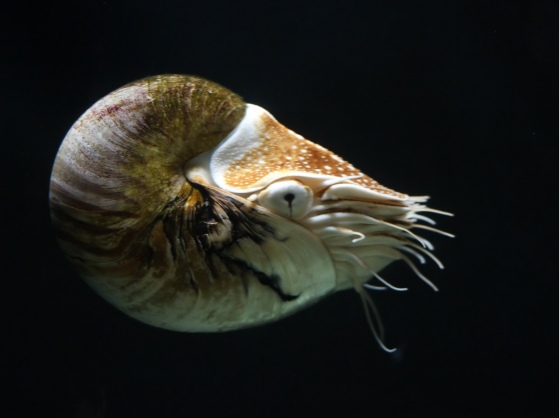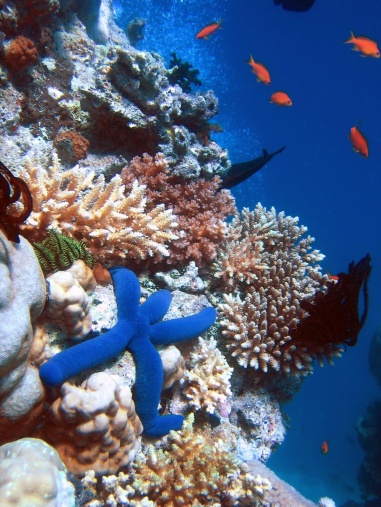25
Ocean acidification is simply the decrease in the pH of all of the oceans on Earth. But is it really that simple? The answer is no, it is not that simple. The ocean absorbs about 25% of the atmosphere’s carbon dioxide or CO2, and as atmospheric CO2 levels increase, so does the amount of CO2 that the ocean absorbs. Therefore, as the amount of greenhouse gases increase, not only does the temperature of the ocean begin to rise, but the increase in CO2 levels causes the ocean’s pH levels to decrease. The rising acidic conditions cause a multitude of deleterious effects from limiting the formation of skeletons for marine organisms, to limiting coral growth, and corroding already existing coral skeletons.
While natural levels of carbon dioxide are fine, the excess CO2 that humans have managed to produce through burning fuels are the major problem. This is largely because when CO2 dissolves in the sea water, (CO2 + H2O-> H2CO3), it produces carbonic acid. While carbonic acid is not as strong of an acid, as say HCl, it still acts as an acid by donating protons, and interacting with surrounding molecules. Now, when excess acid is added to a solution, it causes the pH of that solution to drop, or become more acidic, and while H2CO3 is not considered a strong acid, it still has the potential to massively impact the entire chemical makeup of the ocean environment. The lower the pH of a solution gets, the higher the concentration of H+ ions in that solution. This has become a massive problem for many species.
Chemical reactions can be extremely sensitive to any fluctuation in pH levels, however, in the ocean, these pH changes can affect marine life through chemical communication, reproduction, as well as growth. In particular, the building of the skeletons in marine life is extremely sensitive to any change in pH. Thus, the current increase in CO2 levels that have caused a more acidic environment, have greatly and negatively impacted the growth of new shells.

This is because Hydrogen ions easily bond to carbonate (CO3 2-) molecules to create carbonic acid, and a marine animal’s shell consists of Calcium Carbonate (CaCO3). In order for marine animals to build shells, they take Calcium ions (Ca2+) with a carbonate molecule from the seawater surrounding it, to form the Calcium Carbonate needed to build their shells. So, instead of the carbonate giving all of it’s attention to Calcium so that the marine animal can build it’s shell, it now pays more attention to the Hydrogen ion. In addition, Hydrogen ions have a greater attraction to carbonate, than a Calcium ion does to carbonate, and when two Hydrogen ions bind to carbonate, it produces a bicarbonate ion, and a marine animal does not have the capability to extract only the carbonate ion. Ultimately, this limits marine animals from building any new shells for themselves, and even if the marine animal has the ability to build a new shell, it takes a lot of energy to do so, essentially taking away from other important processes and activities.

Not only can this affect the formation of new shells, but in the right conditions, it can corrode already existing shells. When there are too many Hydrogen ions floating around, and not enough molecules for them to bind to, they can actually start breaking the already existing Calcium Carbonate molecules apart, ultimately breaking down the marine animal’s shell that already exists.
Another organism that feels the effects of ocean acidification are corals. Similar to other marine animals that build their homes with calcium carbonate, reef-building corals also use calcium carbonate to build their own bodies and structures. These reef-building corals are also home to other coral animals and other organisms. As mentioned before, the increased acidification greatly limits any further growth of new coral, as well as corrodes any pre-existing coral reefs. Even if a coral reef has surpassed all the odds, and has been able to grow, it will be a weaker reef that is subject to natural erosion. It has been predicted that by the middle of the century, healthy coral reefs will be eroding more quickly than can be reproduced.

This is bad news for the species that live in these coral reefs. If these species are not able to grow and develop in a safe settlement, such as the coral reef, these larvae will be unable to reach adulthood, thus being unable to reproduce. This will ultimately lead to a mass extinction in the future.
The information in this chapter in thanks to content contributions from Jaime Marsh and Morgan Tupper.
